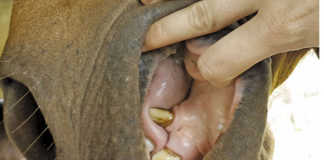As noted previously in this column, the importance of healthy hooves cannot be underestimated. In this issue, we continue our examination of hooves and show why the saying ‘no hoof, no horse’ is so apt. The ‘frog’ is a V-shaped structure that extends across two-thirds of the sole, and changes constantly in response to the terrain and demands placed on it by the leg.
The frog’s width should be roughly 50% to 60% of its length. The portion closest to the point should be substantial enough to reach the ground when the horse puts weight on the hoof. It is important for the point of the frog to touch the ground, otherwise the fibrocartilage at the back of the foot develops badly and can atrophy, causing weakness in the the heel.

The importance of a perfectly balanced hoof cannot be over-emphasied. Photo by Kim Dyson
A healthy frog has a shallow central sulcus (furrow) that is wide enough for an index finger to fit in. A contracted central sulcus results in a lack of oxygen, which can cause thrush to flourish. What’s more, the sulcus will remain contracted until the thrush is treated. To treat the thrush, soak the hoof in a solution of Epsom salt, iodine and warm water for 20 minutes, and pat it dry.
A small amount of rubbing alcohol can be dribbled onto the frog to get rid of the water (methylated spirits also works well), before pouring a blend of eucalyptus and tea tree essential oils onto the thrush-affected area. Repeat for a few days.
Thrush can cause lameness because the horse will try to avoid using the back of its foot.
Identifying problems
The two grooves on each side of the frog, called collateral sulci, are invaluable when trying to identify problems inside the hoof. These run parallel to the bottom of the coffin bone in the front half of the hoof and the collateral cartilages in the rear half of the hoof. The collateral sulci should be linear and not change or vary in depth. Many horse owners do not realise that, unlike many of the other hoof structures, the depth and contour of the collateral sulci are not influenced by hoof care.
Taking a photograph of a healthy hoof on the ground will enable you to measure the distance between the ground and the collateral sulci where they converge at the apex of the frog. This distance should be 10mm to 12mm. The coffin bone’s concave solar surface (found on the bottom of the bone, just above the sole of the hoof) is located 10mm or 11mm above this point.
Long toes or underrun heels are a sign of poor heel development: the collateral sulci develop an undulating shape and become noticeably deeper in the heel. In this case, a vet should take X-rays of the hoof to check the position of the coffin bone. Usually the palmer/plantar process of these coffin bones is dangerously close to the ground.
When this conformation is present in a hind limb, it is usually associated with pan in the hocks, suspensory ligaments, gluteal and lumbar regions. It is best to arrange for regular visits by a qualified farrier. Having your horse’s hooves seen to every four to six weeks is a small price to pay to avoid problems developing.
Other tips
High quality hay and lucerne are not only good for the horse’s digestive system, but help to ensure healthy hooves.You should also evaluate your paddocks from time to time. If they are too moist or too dry, include water baths or oils in your daily hoof care routine. If the climate is dry, allow the water trough to overflow; this help to keep the hooves moist.












